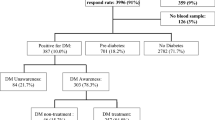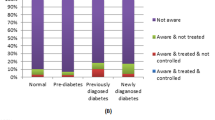Abstract
There is very scanty population-based data on the prevalence of prediabetes, a forerunner to type 2 diabetes, in both rural and urban Nigeria. The purpose of the study was to determine the prevalence and risk factors for prediabetes in a rural Nigerian population. A cross-sectional, village by village, clan-based stratified convenient sampling was done in Ihuokpara, a rural community in Nkanu East Local Government Area of Enugu State, Nigeria. A total of 824 adult men and women participated. Questionnaires were used to obtain sociodemographic data, awareness of diabetes, and common symptoms including family history of diabetes. Fasting plasma glucose and 2-hour post 75g-glucose-load plasma glucose levels were measured after the subjects’ blood pressure and anthropometric indices were obtained. Fasting lipid profile was also assessed in a subset of the study population. Males constituted 34.7 % of the 824 participants. The mean age of the subjects was 51.1 ± 16.2 years. Prevalence of impaired fasting glucose (IFG) was 9.2 %, while that of impaired glucose tolerance (IGT) was 15.8 %. The overall prevalence of prediabetes (both IGT and IFG) was 21.5 %. Hypertension was prevalent at 45.3 % and was the strongest predictor of prediabetes. Obesity was prevalent at 5.8 % and overweight at 16.7 %, while 15.7 % had central obesity. Prevalence of prediabetes was high in the community with hypertension emerging as the possible driving force.
Similar content being viewed by others
References
World Health Organization. Definition and diagnosis of diabetes and intermediate hyperglycemia: report of a WHO/IDF consultation 2006. WHO Library Cataloguing-in-Publication Data.
Banerjee M, Cruickshank J. “Prediabetes”:—is the term useful? Br J Diabetes Vasc Dis. 2004;4:221–5.
Garber AJ, Handelsman Y, Einhorn D, et al. Diagnosis and management of prediabetes in the continuum of hyperglycemia—when do the risks of diabetes begin? A consensus statement from the American College of Endocrinology and the American Association of Clinical Endocrinologists. Endocr Pract. 2008;14:933–46.
Davidson MB, Genuth S, Fagan TF, Palangio MA. American Diabetes Association consensus statement on IFG and IGT Clinical Insights in Diabetes. 2007; 2-3.
Tuomilehto J, Lindstrom J, Eriksson JG, Valle TT, Hamalainen H, Ilanne-Parikka P, et al. Prevention of type 2 diabetes by changes in lifestyle among subjects with impaired glucose tolerance. N Engl J Med. 2001;344:1343–50.
The Diabetes Prevention Program Research Group. Reduction in the evidence of type 2 diabetes with lifestyle intervention or metformin. N Engl J Med. 2002;346:393–403.
Fradkin JE, Roberts BT, Rodgers GP. What’s preventing us from preventing type 2 diabetes? N Engl J Med. 2012;367:1177–9.
The ORIGIN, Investigators T. Basal insulin and cardiovascular and other outcomes in dysglycemia. N Engl J Med. 2012;51:2796–803.
International Diabetes Federation. IDF diabetes atlas, 6th edn. Brussels, Belgium: International Diabetes Federation, 2013. http://www.idf.org/diabetesatlas.
Nigeria Country Programme Document 2014-2017. http://www.unicef.org/nigeria/2013-PL7-Nigeria_CPD-final_approved-English.pdf. Accessed 12 Aug 2014.
Lee M, Saver JL, Hong K, Song S, Chang K, Ovbiagele B. Effect of prediabetes on future risk of stroke: meta analysis. BMJ. 2012;344:3564.
Nathan DM, Davidson MB, Defronzo RA, Heine RJ, Henry RR, Pratley R, et al. Impaired fasting glucose and impaired glucose tolerance—implication for care. Diabetes Care. 2007;30:753–9.
World Health Organization. Definition, diagnosis and classification of diabetes mellitus. Diabetes Care. 1997;20:1183–97.
National Population Commission. Final result of 1991 population census of Nigeria—Nkanu East Local Government Area.
Araoye MO. Research methodology with statistics for health and social sciences. Nathadex 2004.
Faeh D, William J, Tappy L, Ravussin E, Bovet P. Prevalence, awareness and control of diabetes in the Seychelles and relationship with excess body weight. BMC Public Health. 2007;7:163.
Gibson RS. Anthropometric assessment of body composition. Principles of nutritional assessment. New York: Oxford University Press; 1990.
Frolich E. Blood pressure measurement. Can J Cardiol. 1995;11:35H–7.
Friedwald WT, Levy RL, Fredrickson DS. Estimation of the concentration of low density lipoprotein cholesterol in plasma without the use of preparative ultracentrifugation. Clin Chem. 1972;18:499–502.
World Health Organization, International Society of Hypertension Writing Group. 2003 World Health Organization/International Society of Hypertension (ISH) statement on management of hypertension. J Hypertens. 2003;21:1983–92.
World Health Organization (WHO) 2003 Global strategy on diet, physical activity and diet.
International Diabetes Federation (IDF). The IDF consensus worldwide definition of the metabolic syndrome. Final IDF backgrounder 1 document.
Executive summary of the third report of the National Cholesterol Education Program (NCEP) expert panel on detection, evaluation, and treatment of high blood cholesterol in adults (adult treatment panel III). JAMA. 2001;285:2486–97.
Anele D. A brief note on the condition of rural areas in Nigeria. Vanguard news online. http://www.vanguardngr.com/2012/page 879. Accessed 28 Apr 2014.
The DECODA Study Group. Age and sex-specific prevalence of diabetes and impaired glucose regulation in 11 Asian cohorts. Diabetes Care. 2003;26:1770–80.
The DECODE Study Group on behalf of the European Diabetes Epidemiology Study Group. Will new diagnostic criteria for diabetes mellitus change the phenotype of patients with diabetes? Re-analysis of European epidemiological data. BMJ. 1998;317:371–5.
Zhou X, Pang Z, Gao W, Wang S, Zhang L, Ning F, et al. Performance of an A1C and fasting capillary blood glucose test for screening newly diagnosed diabetes and prediabetes defined by an oral glucose tolerance test in Qingdao, China. Diabetes Care. 2010;3:545–50.
Olatunbosun ST, Ojo PO, Fineberg NS, Bella AF. Prevalence of diabetes mellitus and impaired glucose tolerance in a group of urban adults in Nigeria. J Natl Med Assoc. 1998;90:293–301.
Ogbu ISI, Neboh CI. Prevalence of prediabetes among hypertensive patients in Enugu, South-east Nigeria. Niger Med J. 2009;50:14–7.
Gibbs CR, Beevers DG, Lip GYH. The management of hypertensive disease in black patients. QJM. 1999;92:187–92.
Onwubere BJC, Ejim EC, Okafor CI, Emehel A, Mbah AU, Onyia U, et al. Pattern of blood pressure indices among the residents of a rural community in South-east Nigeria. Int J Hypertens. 2011. doi:10.4061/2011/621074.
Ulasi II, Ijeoma CK, Onwubere BJ, Arodiwe E, Onodugo O, Okafor C. High prevalence and low awareness of hypertension in a market population in Enugu, Nigeria. Int J Hypertens. 2011. doi:10.4061/2011/869675.
Spruill TM. Chronic psychosocial stress and hypertension. Curr Hypertens Rep. 2012;12:10–6.
Abubakari AR, Bhopal RS. Systemic review of the prevalence of diabetes, overweight/obesity and physical inactivity in Ghanaians and Nigerians. Public Health. 2008;122:173–82.
Okafor CI. The metabolic syndrome in Africa: current trends. Indian J Endocrinol Metab. 2012;16:56–66.
Iloh GUP, Amadi AN, Nwankwo BO, Ugwu VC. Obesity in adult Nigerians: a study of its pattern and common primary co-morbidities in a rural mission general hospital in Imo State, South-eastern Nigeria. Niger J Clin Pract. 2011;1:181–91.
Acknowledgments
The authors wish to thank the members of the Medical Research and Humanitarian Society of the College of Medicine, University of Nigeria, who participated in this survey.
Conflict of interest
The authors declare that they have no competing interests.
Author contributions
NCB, OEN, UCN, and YEE were involved in the concept, design, definition of intellectual content, literature search, data acquisition and analysis, manuscript preparation, editing, and review. OCI and OCE were involved in the concept and design, literature search, manuscript preparation, editing, and review. All authors read and approved the final manuscript.
Author information
Authors and Affiliations
Corresponding author
Rights and permissions
About this article
Cite this article
Nwatu, C.B., Ofoegbu, E.N., Unachukwu, C.N. et al. Prevalence of prediabetes and associated risk factors in a rural Nigerian community. Int J Diabetes Dev Ctries 36, 197–203 (2016). https://doi.org/10.1007/s13410-015-0401-5
Received:
Accepted:
Published:
Issue Date:
DOI: https://doi.org/10.1007/s13410-015-0401-5




